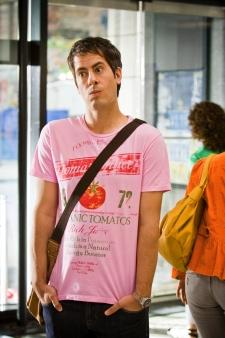At the end of March, CBC announced that it had cancelled its half-hour comedy Sophie, one of only a few Canadian programs to prominently feature a gay character — Matt, played by Jeff Geddis.
Matt’s genesis was from the series’ French predecessor, Les hautes et les bas de Sophie Paquin, whose openly gay creator wanted to craft a new kind of gay character.
“I’ve done a lot of kid’s shows, like Degrassi but like the French version,” says series creator Richard Blaimert. “I’ve done a lot of coming out stories and how it’s so difficult to be gay, so I’ve done all that for let’s say 10 years. When I started to think about Sophie and a gay guy will be her best friend, of course my first thing was that we won’t have any problem with the fact that he’s gay because I’ve done it so many times and I think that we’re at a different place right now.”
The character of Matt was a doctor who was neither a clichéd sexless-best-friend, nor a slutty circuit boy. Over the two seasons, he had two boyfriends as well as an on-and-off dalliance. In one episode, Matt was seen at a bathhouse, begging off one of Sophie’s attempts to get him to babysit for her.
“I think it’s important that he’s alive,” says Blaimert. “We talk about the fact that he has sex.”
“I wanted him to be really modern and the kind of guy that I see in my life, who are afraid to commit sometimes or afraid to jump into a relationship, and no big deal about that.”
With the cancellation of Sophie, it leaves the landscape for queer characters on scripted Canadian television to be fairly bleak. For the three main broadcast networks in Canada — CBC, CTV and Global — Degrassi’s Marco, played by Adamo Ruggerio, is the only regular gay character left on the schedule.
Aside from Sophie, CBC’s Wild Roses also featured a bisexual storyline, but that show was not renewed. CBC’s Canada-US-Ireland co-production The Tudors has featured gay characters in its first two seasons — who virtually all met bad ends — but there are no indications of any gay or lesbian characters in its third season.
The cable side fares only slightly better, with Showcase (owned by Canwest Global) being the only channel that is producing any new scripted shows with queer characters. Currently, they are co-producing a new season of Paradise Falls with here!, and Exes & Ohs with Logo. G-Spot, which just completed its third season, is their only strictly Canadian production that features regular queer characters — a gay man and two lesbians.
“It’s really odd because we’re considered to be such an open-minded, tolerant country compared to our neighbour to the south,” says playwright and television writer Brad Fraser. “Certainly in theatre we haven’t had any shortage of gay work, and when you look at film, some of our best films, and some of our best-known filmmakers are gay and make gay films.”
“It probably says more about the broadcasters and the people who develop television and their feelings about that kind of thing,” says Fraser. “I’ve never gone into a situation where I’ve been developing a television show for Canada, where the powers that be have not tried just on principle just to water it down as much as they can. It says a lot about how we think TV’s supposed to be made and what it’s supposed to do that we don’t really get a lot of risky TV here in Canada.”
Fraser also thinks that because Canadian queers don’t speak up as much about their homegrown programming, it allows the broadcasters to get away without representing them.
“People aren’t vocal about it here the way they are in America,” says Fraser. “Nobody releases a report every year about how many gay and queer characters there are on television, which network has the most of which shows, and which ones are the biggest stereotypes, and that kind of thing.”
American lobby group GLAAD (Gay & Lesbian Alliance Against Defamation) will be releasing their 14th annual “Where We Are On TV” report this fall.
“Viewers can be both entertained and educated by stories on television that reflect the diversity of families and communities across the world,” says GLAAD President Neil G Giuliano. “Images on television and in film have the power to help people embrace their lesbian, gay, bisexual and transgender family members, friends and neighbours with understanding and acceptance.”
GLAAD has also praised the quality of queer representation on Canadian shows that air in the States — such as Degrassi and Sophie.
“There are some great shows that feature well-written [queer] characters produced in Canada that continue to build an audience in the US,” says Giuliano.
But market realities also have a great deal to do with what gets produced in Canada.
“There’s about a hundred times more TV being produced in America, so you get to try a whole bunch of different things to try to grab people,” says Fraser. “Here, if you get two or three shows developed in a year, you’re really lucky.”
OutTV, Canada’s gay and lesbian specialty television channel, is not currently producing any scripted shows in large part because of cost.
“We found it very challenging to find a way to put together what we really want to do, which is a male-orientated soap opera,” says Brad Danks, OutTV’s chief operating officer. “We’ve got a couple of projects in development right now along that way, but they’re not far enough along.”
“It’s a really tough thing to do, because we’ve done a lot of scripted drama before, and it’s a quantum leap in budgets. Our entire budget for the year — all acquisitions, all productions and otherwise — would be used up if we did one series like that.”


 Why you can trust Xtra
Why you can trust Xtra


